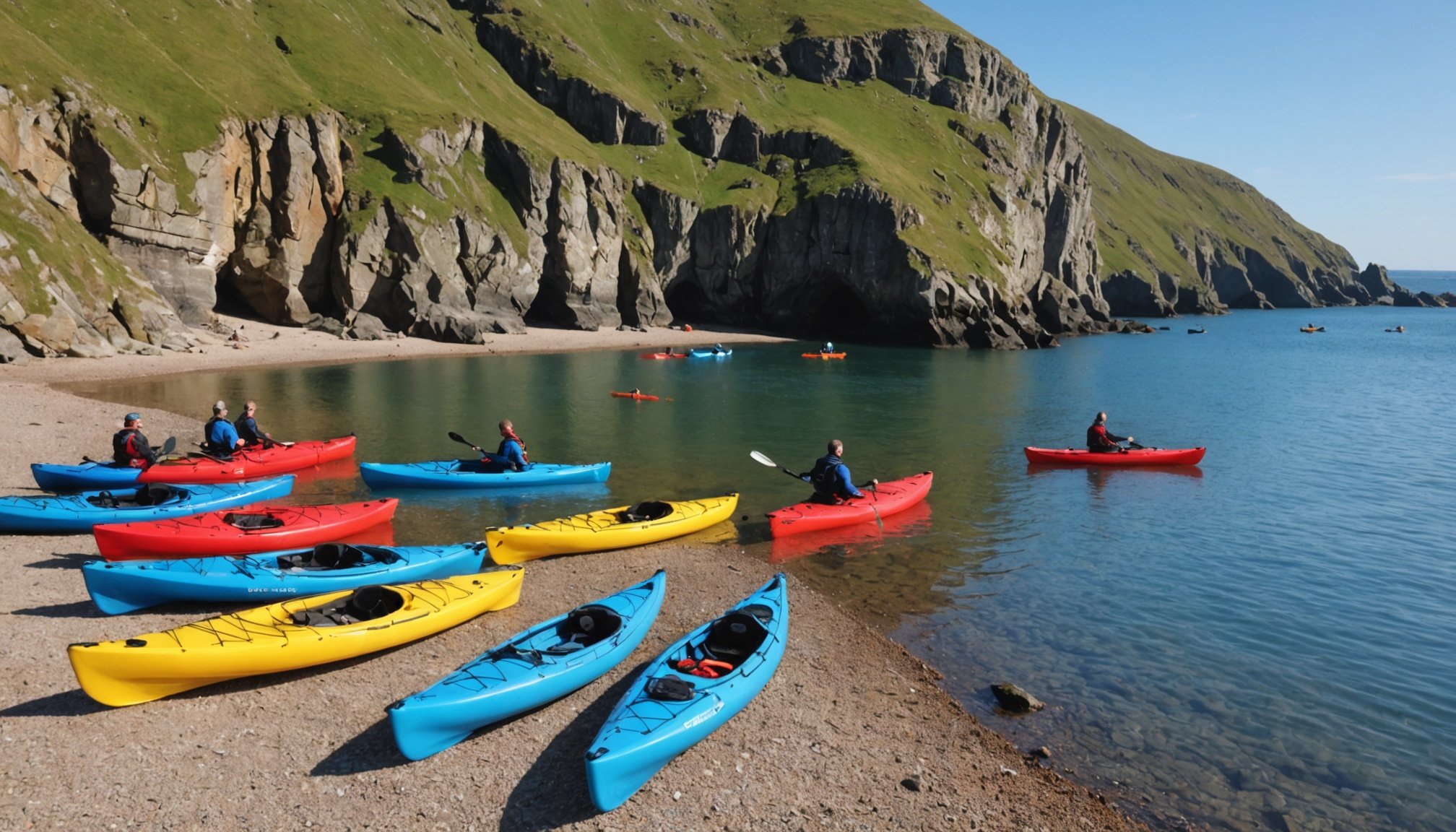Route Planning for Kayaking and Camping
Embarking on a kayaking adventure along the stunning UK coastline calls for meticulous planning. Identify popular kayaking routes that cater to various skill levels. For instance, the Pembrokeshire Coast National Park offers picturesque and diverse routes, suitable for both beginners and seasoned kayakers.
Choosing the right camping spots enhances the overall experience. Seek out spots near kayaking trails to ease daily transitions between paddling and relaxation. Ideal sites often combine accessibility with natural beauty, such as Loch Lomond and the Trossachs National Park, providing a serene setting amid breathtaking landscapes.
Also to read : Escape the digital world: discover the best campsites in the uk for your perfect detox retreat
When planning, it’s crucial to consider tides and currents, as they significantly influence the safety and success of your trip. Understanding these elements can determine your daily schedule and ensure smooth navigation. Resources like tide charts are invaluable for synchronising your departure and arrival with favourable conditions.
In summary, successful route planning hinges on selecting the appropriate kayaking routes and camping locations, while diligently accounting for tides and currents. Equip yourself with knowledge and tools to adapt your itinerary and ensure an unforgettable coastal adventure.
Also to discover : The complete handbook for thrilling winter camping in the uk: must-know tips for your cold-weather expedition
Essential Gear for Kayaking and Camping
Embarking on a kayaking and camping adventure requires careful consideration of essential kayaking gear and camping equipment. Ensuring that you have the right gear can enhance both safety and enjoyment. Prioritising must-have items in your packing list is crucial for a successful coastal trip.
For the kayaking portion, consider these essentials:
- Buoyancy aids: Essential for safety, these provide critical support in case of capsizing.
- Waterproof mobile phone case: Keeps your device dry, crucial for navigation and emergencies.
- Dry bags: Protect your belongings from water damage, keeping clothes and electronics safe.
Camping equipment should focus on portability and resilience, including a lightweight tent for easy setup and dismantling. Sleeping bags suited for coastal climates will ensure comfort during cooler nights. Remember to include a reliable camp stove or portable cooking gear to prepare meals with ease.
Organising your packing list strategically ensures nothing is overlooked. Revisit your list before departure to confirm all items are packed and functional. By choosing gear tailored to a coastal setting, your expedition along the UK coast is poised to be both memorable and seamless.
Safety Tips for Coastal Kayaking and Camping
Embarking on a coastal kayaking and camping trip requires careful consideration of safety measures. Understanding local weather patterns is crucial. Obtain weather-related information in advance to anticipate conditions and make informed decisions regarding your kayaking safety and camping safety.
Equip yourself with essential safety equipment. A whistle, high-visibility clothing, and flares are indispensable for effective signaling. A first-aid kit and multi-tool ensure preparedness for any minor emergencies, improving your overall safety strategy.
Efficient guidelines for safe navigation start with detailed mapping and the use of navigational tools like compasses or GPS devices. Being familiar with local landmarks enhances your navigational skills and can be a great backup if electronic devices fail.
Moreover, emergency preparedness is pivotal. Ensure someone knows your itinerary and check-ins are scheduled. Have a clear understanding of the local emergency services and their contact information. Educating yourself on basic survival skills, such as building a shelter or sourcing water, can enhance your resilience should an unforeseen situation arise.
Remember, respecting your environment and understanding its nuances are key aspects of enjoying a safe and memorable journey along the UK coastline.
Local Wildlife and Environmental Considerations
In exploring the UK coastline, encountering diverse coastal wildlife is inevitable. Common sightings may include seals, diverse seabird species, and marine mammals such as dolphins. While observing these creatures, always maintain a respectful distance. This practice not only ensures wildlife safety but also preserves their natural habitats.
In terms of environmental protection, your actions have a significant impact. Adopt Leave No Trace principles by ensuring all waste is disposed of responsibly. Avoid disturbing natural vegetation, and stick to established paths to minimise habitat disruption. Be mindful of local guidelines, such as seasonal nesting areas, to prevent unintended disturbances.
Additionally, regarding wildlife safety, avoid feeding animals. This practice can alter natural behaviours and lead to dependency, ultimately harming their well-being and ecosystem balance. In the event you encounter an animal in distress, contact local wildlife authorities rather than attempting to intervene yourself.
Practising consistent environmental protection enhances the experience for both adventurers and wildlife alike. By adhering to these considerations, you create a sustainable interaction with the environment, allowing future generations to enjoy the UK’s coastal wonders. Safely engaging with the natural world enriches your kayaking and camping adventures and contributes to preserving the beauty of these marine ecosystems.
Tide Schedules and Coastal Navigation
Understanding tide schedules is fundamental when planning kayaking outings along the UK coastline. Tides can drastically affect both safety and the enjoyment of your trip, influencing water levels and currents that may alter your intended route. Using accurate tide charts ensures that you set off and return under optimal conditions, minimising risks associated with rapidly changing tides.
Embracing coastal navigation techniques is essential for a smooth journey. Familiarise yourself with navigational tools such as a compass or GPS to maintain your course. Landmarks can serve as helpful guides; however, tide fluctuations can obscure familiar visual cues, making technological tools indispensable.
Timing your trip around tidal movements is a strategic move. Plan to paddle during rising tides or when the current is in your favour. This can significantly reduce physical exertion and enhance control over your kayak. Additionally, plan to set up camp or rest during low tides when beaches are more accessible.
For safe kayaking, revisit your tide charts regularly and adjust your itinerary as necessary. Prioritising this aspect of preparation supports an enjoyable and secure adventure, allowing you to fully savour the natural splendour of the UK’s coastal environments.
Itineraries and Trip Planning
Embarking on a kayak-camping trip along the UK coastline involves strategic itinerary planning to balance adventure and relaxation. Crafting trip itineraries for varying skill levels ensures an inclusive experience. Beginners might enjoy a short weekend exploring sheltered bays, while seasoned kayakers may opt for a week-long coastal adventure traversing diverse marine environments.
Consider integrating suggested stops beyond kayaking and camping to enrich your journey. Historical sites, local markets, or charming villages adjacent to your route offer cultural immersion. Nature reserves may serve as tranquil pauses, allowing for wildlife observation and environmental appreciation.
For those seeking a more tailored experience, customising your trip itinerary according to personal preferences adds a personalised touch. Evaluate factors like desired physical exertion, interest in specific wildlife encounters, or the allure of certain landscapes. Ensuring flexibility within your plan supports impromptu detours or special opportunities.
Don’t forget to review trip logistics, such as transportation options to and from start points. Align your interests with the diverse offerings along the UK coastline. Planning methodically ensures your kayak-camping trips are fulfilling, providing both challenge and ease against the backdrop of the stunning UK waters and landscapes.
Handling Potential Challenges
Embarking on a kayaking and camping trip along the UK coastline can pose various challenges. Preparing for potential challenges in kayaking is essential for a successful adventure. Camping concerns in coastal areas often include unpredictable weather and equipment failures, which require proactive problem-solving techniques.
Weather-wise, the UK coast is notorious for sudden changes. This necessitates an adaptable mindset and flexible itineraries. Packing layered clothing can mitigate cold spells, while waterproof gear is vital for unexpected downpours or splashes from the sea. Additionally, familiarise yourself with basic shelter-building skills as a contingency plan for difficult weather.
Equipment issues can disrupt your journey, so always check that all kayaking gear and camping equipment are functioning before setting out. A multi-tool, duct tape, and spare parts should be part of your packing list to address minor repairs. Developing basic repair skills ensures you remain self-sufficient during unforeseen breakdowns.
The essence of tackling challenges rests in anticipation and preparedness. By adopting these strategies, outdoor enthusiasts can not only overcome potential hurdles but also enrich their coastal adventures with confidence, transforming obstacles into opportunities for learning and growth.










